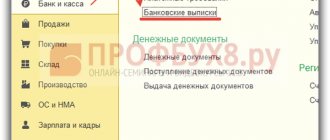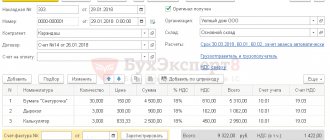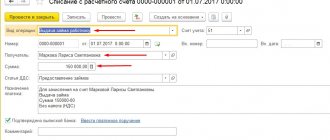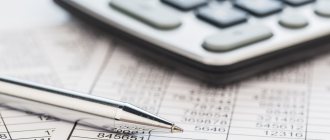The need to maintain separate accounting for VAT arises both when an organization has export operations (not subject to value added tax) and when conducting other business transactions that are subject to VAT.
If an organization simultaneously carries out taxable and non-taxable transactions, taxation problems may arise. This applies to a greater extent to VAT. For example, how to apply input tax to a deduction when combining transactions of different types?
For such operations, the organization is required to maintain separate records. That is, take into account income and expenses separately for taxable transactions, and separately for non-taxable ones.
The main purpose of separate VAT accounting is the distribution of input tax in order to subsequently accept it for deduction. All input value added tax allows deduction of the application of the “5% Rule” on expenses related to both taxable and non-taxable VAT transactions, which include general business expenses.
In this article you will learn how to apply the “Five Percent Rule” for VAT in 2021 and will be able to see a detailed example of the calculation. When combining UTII and OSNO, this rule does not apply.
The essence
Trade organizations often have to combine a general taxation regime with a single tax. The presence of export operations is also the basis for separate accounting. The reason is that when exporting, VAT is deducted on the last day of the month when documents were provided confirming the use of a zero rate for such an operation. The procedure for calculating tax on these transactions is determined by the accounting policy.
Let us consider in more detail how such organizations carry out separate VAT accounting.
To reflect the distribution of the tax amount in the accounting system, subaccounts to account 19 are used. The distribution is carried out in the period in which the goods were registered. Therefore, the proportion is carried out according to comparable indicators - the cost of the goods with and without VAT. Double accounting is also carried out if the organization has operations that are carried out outside the Russian Federation.
Accounting policies are under control
It is the right of the taxpayer not to apply separate accounting if the 5 percent criterion is met. This wording means that the legislator provides the taxpayer with the opportunity to independently choose the method of accounting for “input” VAT. Your choice must be fixed in the accounting policy for tax purposes (clause 2 of article 11 of the Tax Code of the Russian Federation). What if the accounting policy does not stipulate that the taxpayer does not maintain separate accounting until the 5 percent expense ratio is achieved? Then the accountant should not use this rule (clause 12 of Article 167 of the Tax Code of the Russian Federation).
The tax period for VAT is a quarter. The question is, is it possible to start applying the 5 percent criterion not only from the first quarter, but from the second or subsequent quarters? This question should be answered in the negative. The fact is that with separate accounting, non-refundable VAT amounts are taken into account when taxing profits. But the accounting policy for income tax must be established for a year - in accordance with the tax period for this tax (Article 313 of the Tax Code of the Russian Federation). Otherwise it won't be consistent.
But what if non-taxable transactions occurred during the year, when the order on accounting policies has already been submitted to the tax office? In this case, the company has the right to make an addition to its accounting policies. Based on paragraph 16 of PBU 1/98 “Accounting policy of an organization” (approved by order of the Ministry of Finance of Russia dated December 9, 1998 No. 60n), approval of the method of accounting for the first-time facts of economic activity is not considered a change in accounting policy.
Example 1
Let's consider a standard situation. During the quarter, the company shipped products worth 1.2 million rubles, including taxable products worth 0.9 million rubles. The amount of tax presented by suppliers is 100 thousand rubles. Since the cost of the goods, which is not subject to taxation, is 250 thousand rubles, the calculated coefficient is 0.75. Therefore, you can deduct not 100 thousand rubles, but only 75 thousand rubles. (100 * 0.75). And only 25% can be taken into account in the cost of purchased goods: 1.2 * 0.25 = 0.3 million rubles.
When to use separate accounting
Chapter 21 of the Tax Code does not define what separate accounting is. But the accountant understands that its maintenance requires special subaccounts and additional calculations. This means it increases the labor costs of the accounting department. Therefore, the question of whether it is possible to avoid separate accounting is so important. The legislation provides such an opportunity. Let's figure out how to use it.
The obligation to separately record transactions is established by paragraph 4 of Article 149 of the Tax Code for taxpayers who, along with transactions subject to taxation, also carry out transactions that are exempt from taxation. An exhaustive list of “preferential”, that is, not subject to taxation, transactions is presented in paragraphs 1–3 of this article. In addition, separate accounting is necessary in the conditions of combining the payment of UTII with the general taxation regime (clause 7 of Article 346.26 of the Tax Code of the Russian Federation). Separate accounting must be used both when forming the tax base for VAT and when taking into account the “input” tax (clause 1 of Article 166, clause 4 of Article 170 of the Tax Code of the Russian Federation).
However, tax legislation does not use the concept of “separate accounting” in connection with sales, the place of which is not recognized as the territory of the Russian Federation, as well as in cases in which there is no object of taxation (subclause 2, 4, clause 2, article 170 of the Tax Code of the Russian Federation). Therefore, the rules for separate accounting of “input” VAT, prescribed in paragraph 4 of Article 170 of the Tax Code, should not be applied to these business transactions.
But financiers think differently. In letters dated June 6, 2008 No. 03-07-08/145, dated April 28, 2008 No. 03-07-08/104, etc., the Ministry of Finance of Russia equates sales outside the territory of the Russian Federation to sales operations that are not subject to taxation . One can argue with this opinion. After all, tax legislation does not allow for a broad interpretation (Clause 5, Article 3 of the Tax Code of the Russian Federation). Due to the literal wording of subparagraph 1 of paragraph 1 of Article 146 of the Tax Code, sales outside the territory of the Russian Federation take place “not recognized as an object of taxation.” And the concept of transactions “not subject to taxation” clearly originates from Article 149 of the Tax Code.
Calculations
How to distribute input VAT? An enterprise may have fixed assets and intangible assets registered in the first month of the quarter. In such cases, the proportions are determined based on the share of the cost of shipped goods manufactured on a new machine in the total sales amount for the month in which the object was accepted for accounting.
The cost of services for providing loans and repo transactions is calculated based on the amount of income in the form of accrued interest. The exception is an interest-free loan, the cost of which is equal to zero. Such operations do not affect the proportion
When calculating the Central Bank, the difference between the sale price and acquisition costs is calculated. At the same time, non-VAT-taxable transactions must also be taken into account in the cost of work.
Maintaining separate accounting for VAT when exporting: main points
Separate accounting for VAT when exporting products is required. In this case, the raw materials that were used in the process of export operations (the amount of operations) must be submitted to the Federal Tax Service in the form of a declaration with a zero rate.
The norms of the current Russian legislation do not provide for a clearly defined methodology for determining the input VAT of goods for export. A convenient accounting method is chosen by the organization independently. The accounting procedure should be fixed in the relevant documents (in orders related to the accounting policy of the enterprise).
If the organization did not previously assume that it would export goods and applied regular input VAT on a general basis, then the tax that was paid can be restored. To do this, the organization submits a declaration (updated) and pays tax.
5% rule
For those periods when the share of expenses on non-taxable transactions is less than 5% of the total amount of expenses, the company may not carry out separate accounting. The procedure for calculating the total amount of expenses when calculating the barrier is not established by law. An enterprise can develop its own justified methodology and consolidate it in its accounting policies.
When calculating the share, all sales excluding VAT are taken into account: non-taxable transactions, sales on imputation, expenses for transactions outside the Russian Federation. As for the first group, both direct and general expenses are taken into account. That is, you need to add up all the costs, add VAT on general business expenses in the appropriate proportion, then divide the resulting amount by the amount of costs.
The “5 percent” rule for VAT, an example of the calculation of which will be presented below, cannot be applied to export transactions. This is provided for in Art. 170 NK. For such transactions the VAT rate is 0%. That is, if:
- the barrier has not been reached;
- the enterprise has export operations;
It is necessary to carry out separate VAT accounting.
Comparing expenses
Calculating the cost ratio is not as simple as it seems at first glance. But let's sort it out in order.
At the end of the tax period, the accountant will have to compare the total amount of production expenses and the amount of production expenses directly attributable to preferential sales operations. According to the author, “mixed” expenses that support production of taxable and non-taxable activities do not need to be distributed for the purposes of the upcoming calculation.
This conclusion follows from paragraphs one through four of paragraph 4 of Article 170 of the Tax Code in their interrelation. Indeed, the costs of producing preferential products are nothing more than the cost of resources (goods, works, services, property rights) used to carry out tax-free transactions. In paragraph two, the legislator clearly states that they must be direct. There is no reason to go beyond this approach in order to calculate the share specified in paragraph nine of this paragraph. Paragraph three, in turn, talks about the direct costs of carrying out taxable transactions. And in paragraph four of paragraph 4 of Article 170 of the Tax Code we are talking about indirect costs. In total, such costs are precisely the total costs of production. The clarification “total costs” combines costs for the production of different types of products (goods, works, services, property rights), and does not at all require the preliminary distribution of indirect costs to direct cost items.
An additional argument in favor of this conclusion is the requirement for rational accounting, enshrined in paragraph 7 of PBU 1/98 “Accounting Policy of the Organization” (approved by order of the Ministry of Finance of Russia dated December 9, 1998 No. 60n). Indeed, in our case we are talking about the formation of an indicator below the generally accepted threshold of materiality.
As a result, expenses for non-taxable operations are selected as direct expenses in analytical accounting under account 20 “Main production”, as well as under accounts 21 “Semi-finished products”, 23 “Auxiliary production” and 29 “Service production and farms” - if subsequently they are not subject to closing on a score of 20 or on each other. General production costs are formed taking into account indirect costs, which are reflected in accounts 25 “General production expenses” and 26 “General business expenses”.
Example 1
The plant produces bicycles and wheelchairs for the disabled. The sale of the latter is exempt from taxation (subclause 1, clause 2, article 149 of the Tax Code of the Russian Federation, Decree of the Government of the Russian Federation of December 21, 2000 No. 998). Accounting reflects direct costs for the production of these products in the subaccounts “Bicycles” and “Wheelchairs” of account 20. For the fourth quarter of 2008, direct costs for production amounted to 10,000,000 rubles, of which for wheelchairs - 600,000 rubles, according to bicycles – RUB 9,400,000. In addition, general production expenses were incurred in the amount of RUB 2,000,000. and general business expenses in the amount of RUB 3,000,000.
Based on these data, the control ratio between expenses will be equal to 4% (600,000 rubles: (10,000,000 rubles + + 2,000,000 rubles + 3,000,000 rubles) × 100%). On this basis, the accountant has the right not to keep separate records of “input” VAT in the fourth quarter. He will submit the entire amount of tax presented by suppliers and contractors for deduction.
However, he will show revenue not subject to VAT in section 9 of the value added tax declaration, approved by order of the Ministry of Finance of Russia dated November 7, 2006 No. 136n, under code 1010204. And in column 3 of this section he will reflect the direct cost of preferential products - 600,000 rub. But in column 4 of section 9 there will be a dash.
Now assume that the firm has no direct expenses for non-taxable transactions. In such a situation, the percentage we are interested in will be equal to zero, which is obviously less than 5 percent. This means that it is not necessary to distribute the “input” VAT.
The legislation does not contain clear instructions on the procedure for determining the ratio of expenses for preferential production and total production costs. Therefore, firms have the right to develop their own algorithm for calculating the control ratio
If the control ratio is calculated by a trading company, then its direct costs for non-taxable transactions will be the cost of non-taxable goods sold.
We emphasize that paragraph four of paragraph 4 of Article 170 of the Tax Code requires the distribution of VAT, and not the indirect costs themselves. Meanwhile, a number of experts believe that the costs of preferential transactions should include a share of indirect costs (from accounts 25, 26, and in trade - from account 44). Perhaps the legislation does not contain unambiguous instructions on the procedure for determining expenses, moreover, the conditions of economic activity are infinitely varied. Therefore, we believe that firms have the right to develop their own reasonable approach to calculating the benchmark cost ratio. To avoid disagreements with tax authorities, we recommend that the chosen algorithm be described in detail in the accounting policy.
Please note that the ninth paragraph of paragraph 4 of Article 170 of the Tax Code does not apply to exporters. For the reason that applying a tax rate of 0 percent is not an exemption from taxation.
The 5 Percent Rule: An Example
The enterprise's direct costs for taxable operations in the second quarter amounted to 15 million rubles, and for non-taxable ones - 750 thousand rubles. General business expenses - 3.5 million rubles. The accounting policy provides for the distribution of expenses in proportion to revenue, which in the reporting period amounted to RUB 21 million, respectively. and 970 thousand rubles.
General business expenses for non-taxable transactions: 3.5 * (0.97 / (21 + 0.97))) = 154.529 thousand rubles, or 4.7%. Since this amount does not exceed 5%, the company can deduct the entire input VAT for the second quarter.
"Saving" clause
The ninth paragraph of paragraph 4 of Article 170 of the Tax Code allows you to get rid of separate accounting of “input” VAT. But please note that it is addressed to taxpayers. For this reason, the said paragraph does not apply to UTII payers. After all, these business entities are not considered VAT payers due to the direct indication of paragraph 4 of Article 346.26 of the Tax Code. This point of view is reflected in the letter of the Ministry of Finance of Russia dated July 8, 2005 No. 03-04-11/143 and in the letter of the Federal Tax Service of Russia dated May 31, 2005 No. 03-1-03/897/8. But the judges do not share the opinion of the officials (resolutions of the Seventeenth Arbitration Court of Appeal dated July 18, 2008 No. 17AP-4390/2008-AK, FAS Volga District dated February 5, 2008 No. A65-28667/06-SA2-11, FAS North Western District dated December 7, 2007 No. A05-5928/2007, etc.).
As a result, without the risk of tax disputes, only taxpayers using VAT exemption benefits have the right to apply this rule. And even then only under certain conditions. Alas, these conditions must be confirmed after each VAT tax period, that is, quarterly.
So, separate accounting of “input” VAT may not be carried out if the costs of carrying out preferential operations do not exceed 5 percent of the total production costs. In this case, the taxpayer can deduct the entire “input” VAT. There is no need to include VAT in the cost of goods, works, or services. This means that there is no need to distribute the “general” VAT by calculation between taxable and non-taxable transactions. But no one exempted taxpayers from separate accounting of income.
The following immediately catches your eye. The final distribution of expenses by type of activity will be determined at the end of the quarter. Of course, it is not known in advance whether the specified 5 percent ratio between expenses will be met. Therefore, it is risky to deliberately refuse to separately account for “input” tax amounts. If it turns out that the 5 percent threshold is exceeded, then expense accounting for the quarter will need to be restored. And companies paying monthly advance payments based on the actual profit received (clause 2 of Article 286 of the Tax Code of the Russian Federation) will have to submit corrective declarations. Their expenses will increase due to non-refundable tax amounts.
Accounting algorithm
To understand what VAT rate should be applied to goods and how to determine the amount of input tax, you can use the following sequence of actions:
1. Calculate the amount of VAT claimed that can be deducted. If the purchased goods can be directly attributed to activities exempt from taxation, then VAT is included in its cost. In other cases, the tax amount is deducted.
2. At the next stage, you need to apply the “5 percent” rule for VAT, an example of the calculation of which was presented earlier. First, the amount of expenses for non-taxable transactions is determined, then the total costs are calculated and the formula is applied:
% neoreg. oper. = (Normal / Total) x 100%.
If the resulting ratio exceeds 5%, then separate accounting of the amounts should be carried out.
3. Tax amounts with and without VAT are calculated, then they are summed up and the ratio is determined:
% calc. = (Sum of region / Sum of total) * 100%.
The following determines the VAT on OSN payable:
Tax = VAT charged * % deducted.
4. The marginal cost is calculated:
VAT limit = VAT claimed - VAT deducted
or
Cost = (Amount of goods shipped, but not taxable / Total sales volume) * 100%.
Procedure for distribution of input VAT (posting)
In order to create the necessary proportion used to determine the share of input tax attributable to taxable and non-taxable transactions, several types of expenses are distinguished:
- expenses relating only to taxable transactions;
- expenses related only to non-taxable transactions;
- other expenses that are difficult or impossible to classify into any category.
When creating accounting records, it is advisable to enter subaccounts to account 19, reflecting the input tax on transactions of various types. In this case, the entries for determining the tax when purchasing goods using a subaccount for taxable and VAT-free transactions will look like this:
- Dt 41 Kt 60 - reflects the amount of goods received from the supplier excluding tax.
- Dt 19 Kt 60 - the amount of VAT has been allocated, which can subsequently be taken to reduce the tax.
- Dt 68 Kt 19 - input VAT accepted for deduction.
- Dt 41 Kt 19 - reflects the amount of VAT used for non-taxable transactions and included in the cost of the purchased product (material, service).
Depending on the type of activity of the organization, along with account 41, accounts 25, 26, 10 and others can be used.
In some cases, taxpayers initially accept the entire amount of tax as a deduction, actually performing transactions related to different types of VAT taxation. And after that, part of the tax that goes to non-taxable activities is restored.
However, the Federal Tax Service has its own opinion regarding this technique. Tax officials insist that separate VAT accounting must be recorded at the time the goods are accepted for registration. In some cases, when conflict situations arise with control authorities, taxpayers manage to defend their position enshrined in the organization’s accounting policies.
Examples of drawing up proportions that take into account all the requirements of legislation and tax structures, as well as the accompanying transactions, can be found in the article “What is the procedure for distributing input VAT?”
Arbitrage practice
A complete interpretation of “total expenses” is not provided in the Tax Code. Based on definitions in economic dictionaries, this term can be understood as the total cost of production of goods incurred by the taxpayer himself. The Ministry of Finance explains that when calculating this value, direct and general expenses for conducting activities are taken into account.
Judicial practice also does not allow us to draw an unambiguous conclusion regarding when separate VAT accounting should be carried out. The 5 percent rule, an example of which was discussed earlier, applies exclusively to manufacturing enterprises. According to the judges, trading companies cannot carry out separate tax accounting.
Transactions with securities raise even more questions. In particular, some judges, referring to Art. 170 of the Tax Code, they claim that when selling such assets, the 5% rule can be used. At the same time, the cost of purchasing securities does not affect the proportion. That is, almost always the amount of expenses will be less than 5%, and the payer will be released from the obligation to keep double records.
In other court decisions there is a reference to PBU 19/02, which states that all transactions with the Central Bank in NU and BU relate to financial investments. In addition, organizations do not have expenses associated with the formation of the cost of such assets. That is, income from such transactions is exempt from taxation. Therefore, the organization must submit full VAT for deduction.
Transactions on the sale of a legal entity’s share in the management company of another organization are not subject to VAT. Therefore, in such cases double counting is always carried out.
Advice for organizations conducting transactions that are not subject to VAT
If an organization is engaged in operations that are not subject to value added tax on an ongoing basis, then in order to calculate the share of expenses for these operations, accounting should be organized in such a way that the following information is generated separately:
1. About the cost of sales, which are subject to VAT. 2. About the cost of sales, which are not subject to VAT. 3. About other costs associated with implementation:
- subject to VAT (for example, on the sale of fixed assets);
- exempt from VAT (for example, sales of securities).
4. About other expenses that are not related to sales (for example, interest received by the company on loans).
To make it more convenient to keep track of transactions, it is recommended to open separate sub-accounts. In addition, you can maintain separate registers.
We add that the organization should decide on the optimal procedure for calculating the share of general business expenses that fall on operations not subject to value added tax.
For example, the share of general business expenses attributable to operations that are not subject to VAT can be taken equal to one of the following ratios:
- the share of direct expenses for operations that are not subject to VAT in the total direct expenses for all operations that are related to the sale;
- the share of revenue from operations that are not subject to VAT in the total amount of sales revenue.
No less important is the issue of tax policy for separate accounting in relation to transactions that are not subject to VAT. It is worth paying attention to such points that are associated with the grounds for performing such operations, namely:
1. What preferential regimes are associated with taxation. 2. Are there any tax transactions that are not provided for in Article 149 of the Tax Code of the Russian Federation? 3. Availability of the right to exemption from VAT in case of insufficient amount of revenue received. 4. Sales of products (services or works) to other countries.
Example 3
Before providing funds as collateral, the company hired auditors to check the financial condition of the borrower. The cost of the company's services amounted to 118 thousand rubles. VAT included. Loan amount – 1 million rubles. The cost of financial investments is determined based on the accounting policies of the lender. If it does not provide for the use of the 5% rule, then VAT for auditor services should be taken into account in the cost of the financial investment. In this case, general business expenses will have to be distributed. If there is a reservation, then all amounts are accepted for deduction.
The issue of accounting for input VAT in transactions with debt securities remains open. Using a preferential scheme for transactions with bills of exchange is risky. The Federal Tax Service will most likely challenge such operations, and then they will have to prove their case in court.
Let's sum it up
Refusal of separate accounting of “input” VAT reduces the tax burden of the company, which entails losses for the budget. Indeed, savings in connection with income tax expenses are recognized at a tax rate of 24 percent, while VAT is deducted in full. Therefore, tax authorities carefully monitor the validity of the tax benefit in connection with the application of the 5 percent threshold. But we have seen that this norm contains a number of ambiguities. Therefore, the situation requires informed decisions. In itself, the 5 percent criterion for the VAT accounting procedure is similar to the principle of materiality in accounting. The same 5 percent threshold is established for it (clause 1 of the Instructions on the procedure for drawing up and presenting financial statements, approved by Order of the Ministry of Finance of Russia dated July 22, 2003 No. 67n). This similarity is noted in the resolution of the Federal Antimonopoly Service of the Ninth Arbitration Court of Appeal dated May 4, 2008 No. 09AP-4395/2008-AK.
- Issues of maintaining separate accounting were discussed in the article “Separate accounting: rules and problems”, VAT No. 7, 2008.
Accounting
From all of the above, we can draw the following conclusion: it is better to determine the method of calculating expenses and indicate it in the accounting policy. In this case, you need to specify the entire list of costs that relate to operations exempt from taxation, and the procedure for their calculation:
- allocate a position on staff for a responsible employee;
- prescribe the procedure for recording time for making calculations;
- determine the principle for distributing the amount of rent and utilities for such operations (for example, proportionally).
To collect information about expenses not related to production, account 26 is used. It can reflect management, general business expenses, depreciation, rent, costs of information, auditing, and consulting services.
Maintaining separate accounting for VAT: what to pay attention to
The vast majority of organizations deal with both taxable and non-taxable value added tax products.
Let us remind you that separate accounting for this tax is carried out according to the output VAT - at the cost of the products that were shipped. In this case, products may be subject to VAT or exempt from it. VAT included in the product price must also be taken into account.
However, there is no single methodology for maintaining separate VAT accounting. That is why you can use a convenient order for organization. The most important thing is that when maintaining separate accounting, transactions subject to VAT and those not subject to VAT are clearly distinguished.
The procedure for maintaining separate VAT accounting chosen by the organization must be enshrined in the general accounting policy of the company.
Failure to maintain correct separate VAT accounting may result in tax authorities recovering all input tax on items purchased for use in transactions that are and are not subject to value added tax. Such actions by tax officials will lead to the organization having shortfalls in VAT, which means fines and penalties cannot be avoided.
The Ministry of Finance believes that if there are no transactions on exempt units of goods from VAT, then this is the basis for exempting the organization from maintaining separate accounting for value added tax.
VAT or UTII for individual entrepreneurs
To begin with, it is worth noting that entrepreneurs who are single tax payers do not pay VAT on transactions that are recognized as taxable. At the same time, the Tax Code states that organizations that carry out transactions subject to VAT and UTII are required to maintain double accounting of property, liabilities and transactions. For such individual entrepreneurs, the VAT accounting procedure is regulated by the Tax Code. It also spells out the work procedure of exporters located on UTII for individual entrepreneurs.
Separate accounting allows you to correctly determine the amount of tax deduction: in full or in proportion. The code states that the procedure for distributing such operations must be prescribed in the accounting policies of the organization. The above ratio is calculated based on the cost of non-taxable goods sold in total sales. Let's consider another problem that presents the “5 percent” rule for VAT.
Calculation example. An enterprise engaged in wholesale and retail trade (paying VAT and UTII) must carry out double tax accounting. Even if work, equipment, or real estate are intended for “imputed” activities, VAT on them is not deductible. If the services received or real estate purchased are intended to conduct transactions subject to VAT, then the tax charged is taken into account in full. If the purchased equipment will be used on “two fronts” at once, then a proportion must be drawn up. One part of the tax is deductible, and the second is included in the cost of goods.
Is trading activity manufacturing?
Taking a closer look, we will find that a 5 percent criterion has been introduced for taxpayers engaged in the production of goods (works, services) and property rights. What about taxpayers carrying out trading operations?
The Ministry of Finance of Russia, in letter dated January 29, 2008 No. 03-07-11/37, agreed that this rule can also be applied to trading activities. True, this is the first time such a position has been officially announced.
Meanwhile, the Russian Ministry of Finance itself, in a letter dated August 7, 2007 No. 03-02-07/2-138, indicated that its letters on the application of tax legislation are of an informational and explanatory nature, and not of a regulatory nature. The interpretation of financiers does not prevent tax authorities from being guided by the norms of legislation on taxes and fees in a different sense.
For this reason, traders, including individual entrepreneurs, should not ignore negative arbitrage practices. Thus, in the resolution of the Federal Antimonopoly Service of the Central District dated July 18, 2007 No. A48-602/06-18, the refusal to separate accounting was declared unlawful, since the organization was not a manufacturer of goods, but only sold them. This decision was supported by the Supreme Arbitration Court of the Russian Federation in its ruling dated April 30, 2008 No. 3302/08. A similar conclusion regarding retail trade is contained in the resolution of the Federal Antimonopoly Service of the Volga-Vyatka District dated June 14, 2007 No. A82-6804/2005-99.
The author agrees with the position of the arbitrators and considers it necessary to note the following. Paragraph 1 of Article 11 of the Tax Code establishes that the meanings of concepts not disclosed in tax legislation should be sought in other regulatory sources. First, let's turn to the All-Russian Classifier of Types of Economic Activities OK 029-2001. It follows from it that wholesale and retail trade must be distinguished from production, since these areas are classified under different sections of OKVED. A similar conclusion can be reached by comparing paragraphs 2 and 4 of PBU 5/01 “Accounting for inventories” (approved by order of the Ministry of Finance of Russia dated June 9, 2001 No. 44n). Finally, according to the Instructions for the Application of the Chart of Accounts, approved by Order of the Ministry of Finance of Russia dated October 31, 2000 No. 94n, production costs are reflected in accounting accounts numbered 20–29. And in connection with trade operations, “production” accounts are not used. Trading costs are reflected in account 44 “Sales expenses”. But the most important thing is that paragraph 1 of Article 39 of the Tax Code does not allow identifying trade operations with production, that is, the provision of services.
Proportion
The Tax Code specifies the specifics of accounting for ratios for transactions that are exempt from taxation. The cost of services for providing loans and repo transactions is taken into account in the amount of interest income accrued by the taxpayer. When calculating the cost of shares, bonds, and other securities, the amount of income is calculated in the form of a positive difference between the selling price and the cost of purchasing such assets. If the market price is lower than the cost, then the resulting value will not be taken into account.
Let's get to the bottom of the problem
So, if a company simultaneously carries out taxable and non-taxable transactions, then problematic situations may arise in taxation. First of all, the disputes concern VAT. For example, how to apply input tax to a deduction when combining transactions of different types? Starting this year, officials have adjusted the rules.
In such circumstances, the company is required to maintain separate accounting records. That is, take into account income and expenses separately for taxable transactions, and separately for non-taxable ones.
But it's not that simple. For example, certain types of costs can be allocated to both types of activities: taxable and non-taxable. For example, general business expenses that are incurred to ensure the life of the entity as a whole, regardless of the specific type of transaction. For expenses of this nature, separate accounting for input VAT is applied: the 5 percent rule.
What does it mean? Let's say an organization provides two types of services. The first is classified as non-taxable, and the second is subject to full VAT. Thus, an enterprise has the right to accept input VAT on general business costs in full if expenses for non-taxable transactions do not exceed 5% of total (aggregate) expenses for the corresponding quarter.
Let us note that until 2021, officials took a different position. That is, previously it was possible to accept input VAT as a deduction if expenses within 5% were directed only to non-taxable transactions.
Let's look at an example
Let's look at how the 5 percent VAT rule is determined and an example calculation.
The total expenses of Vesna LLC for the 3rd quarter of 2021 amounted to 1,550,000 rubles, including for:
- Implementation of consulting services - 1,300,000 rubles.
- Provision of educational services (not subject to VAT) - 50,000 rubles.
- General business expenses - 200,000 rubles.
According to the current accounting policy of Vesna LLC, the company decided to distribute general business expenses in proportion to the revenue received for each type of service. Thus, for the 3rd quarter, revenue amounted to 4 million rubles, including:
- Consulting services - 3,500,000 rubles.
- Educational services - 500,000 rubles.
For educational services:
Now we calculate the share of costs for non-taxable services:
Since 4.84% is less than 5%, it means that Vesna LLC has the right to deduct all input value added tax presented by suppliers and contractors for the 3rd quarter of 2021.
Reinstatement of VAT when purchasing real estate
When purchasing (constructing) real estate, the entire amount of VAT on this property is accepted for offset, even if it is used simultaneously in taxable and non-taxable activities.
Next, the accountant must track the use of this object. If it begins to be used in non-taxable activities, then the amount of VAT accepted for deduction must be restored (letter of the Ministry of Finance of the Russian Federation dated July 14, 2017 No. 03-07-11/44832):
- for 10 years from the date of putting the property into operation, the taxpayer must reflect 1/10 of the tax taken into account in deductions in the appropriate share, which is determined by dividing the cost of non-taxable transactions and all transactions for the calendar year;
- the amount is calculated in the accounting statement dated December 31 of each year and recorded in the sales book;
- the property does not participate in the RU input tax, i.e. the rules of Art. 171.1 and paragraph 4 of Art. 170 Tax Code of the Russian Federation;
- if 15 years have passed since the commissioning of the OS or full depreciation has been accrued, then VAT is not restored.
What is a microloan?
The concept of a microloan was first introduced by Federal Law No. 151-FZ of July 2, 2010 “On microfinance activities and microfinance organizations” (hereinafter referred to as the Federal Law).
Article 2 of this law defines that a microloan is a loan provided by the lender to the borrower on the terms stipulated by the loan agreement, in an amount not exceeding the maximum amount of the borrower's obligations to the lender for the principal debt established by Federal Law.
As we can see, in the very concept of a microloan there is already a restriction for a microfinance entity in the form of a reference to the maximum amount of the borrower’s obligations to the lender for the principal debt.
Interest accrual
If you have entered into a contractual relationship with an MFO, then you should understand several very important points:
1) interest stipulated by the microloan agreement can be accrued only for the period until the date of repayment of the loan amount (that’s why it is a short-term loan);
2) outside the loan repayment period, the MFO has the right to charge interest in the amount of the key rate of the Central Bank of the Russian Federation (currently it is 7.5% per annum), and not the “crazy” interest provided for by the terms of the agreement - for comparison, the agreement may indicate 750 % per annum, and this is a significant difference.
Distribution of VAT upon receipt of fixed assets
VAT on the purchase of fixed assets (except for real estate) can be:
- reflect in deductions and return from the budget if the object is used in activities taxed at rates of 10, 20%;
- include funds in the price provided that they participate in transactions without VAT;
- distribute in the case of using fixed assets in taxable transactions and activities without VAT.
The rule for distributing VAT amounts when capitalizing fixed assets does not differ from the method of calculating this tax when goods (works, services) are received. The difference lies in the calculation period during which revenue is determined when calculating the proportion. If the fixed assets were purchased in the first two months of the quarter, then you can distribute the tax according to the month of receipt or act in the usual manner - calculate the proportion according to the revenue data for the quarter. The taxpayer establishes the calculation method independently, registering it in the UP.
You can select a particular period when purchasing an OS under a sales contract. In the case of receipt of fixed assets under a leasing agreement and use in taxable and non-taxable activities, the billing period is set for the quarter, since leasing payments are interpreted as a service (clause 5 of Article 38 of the Tax Code of the Russian Federation), and not as the fact of acquisition of fixed assets, and are not subject to condition sub. 1 clause 4.1 art. 170 Tax Code of the Russian Federation. Amounts of input VAT as part of such payments, which are not deductible, are included in the cost of the lease payment without increasing the fixed asset, and are taken into account in income tax expenses.
VAT register for the “five percent” rule
General provisions on separate VAT accounting
If there are transactions subject to VAT and not subject to VAT, it is necessary to keep separate records of input VAT for goods, works, services (hereinafter referred to as goods) clause 4 of Art. 149 Tax Code of the Russian Federation. The specific procedure for maintaining such records must be enshrined in the accounting policy, paragraph 4 of Art. 170 Tax Code of the Russian Federation; Letter of the Ministry of Finance dated November 20, 2017 No. 03-07-11/76412.
The organization must distribute input VAT as per paragraph. 1, 2 p. 4 tbsp. 170 Tax Code of the Russian Federation:
• VAT relating to goods used for VAT-exempt transactions must be taken into account in the cost of such goods. This will increase expenses for income tax purposes;
• VAT relating to goods used for VAT-taxable transactions can be deducted;
• VAT on goods used simultaneously for taxable and non-VAT-taxable transactions (that is, VAT on general business expenses) is deducted in proportion to the share of revenue from taxable transactions in the total revenue for the quarter:
In the general case (if there was no income from the sale of securities), such a share is calculated according to the following formula e Letters of the Ministry of Finance dated July 19, 2017 No. 03-07-08/45800, dated June 26, 2009 No. 03-07-14/61:
Please note that with this calculation:
• all revenue indicators are taken excluding VAT and for the tax period as a whole - quarter l Letter of the Federal Tax Service dated March 21, 2011 No. KE-4-3/4414;
• as part of the revenue it is necessary to take into account, in particular:
— revenue from VAT-taxable and non-VAT-taxable transactions;
— revenue from transactions that are not subject to VAT;
• there is no need to take into account income that is not recognized as sales revenue, for example:
If during the quarter you received income from the sale of securities, then the formula for calculating the share will be somewhat more complicated. 5 clause 4.1 art. 170 Tax Code of the Russian Federation. The numerator of the formula will remain the same. But in the denominator when calculating the total amount of income, instead of income from the sale of securities, one must take into account only the “tax” profit from their sales and Letter of the Ministry of Finance dated November 26, 2014 No. 03-07-11/60111.
It is not difficult to calculate the discount during the summer sales period. But the calculations for checking compliance with the “five percent” VAT rule are not as easy as it seems
There are other nuances in separate VAT accounting. Thus, when purchasing fixed assets and intangible assets taken into account in the first or second month of the quarter, which are intended for participation in taxable and non-VAT-taxable activities, you can distribute input VAT:
• or in proportion to the share of VAT taxable revenue received in the first or second month. Consequently, the formula for determining the share of revenue will only include indicators for the first or second month of the quarter, respectively. 1 clause 4.1 art. 170 Tax Code of the Russian Federation. Then depreciation accrued starting from the next month will be calculated correctly and will not require adjustments in the future - even if the share of taxable revenue changes at the end of the quarter;
• or in a general manner - that is, based on data for the quarter as a whole. However, in this case, you will not be able to correctly calculate their full initial cost in the month of acceptance for accounting of fixed assets or intangible assets. This means that in the future it may be necessary to recalculate the amounts of depreciation accrued for the quarter. The only advantage of this approach is that in the month the fixed asset was accepted for accounting, you will not have to calculate a separate proportion for the distribution of VAT on a specific fixed asset or intangible asset.
The essence of the “five percent” rule
Input VAT on general expenses associated with both taxable and non-VAT-taxable transactions can be fully deducted if for the corresponding quarter the share of expenses on transactions not subject to VAT does not exceed 5% of clause 4 of Art. 170 Tax Code of the Russian Federation. That is, the following condition is met: Letter of the Ministry of Finance dated July 19, 2017 No. 03-07-08/45800:
Note that data on expenses, as the Ministry of Finance explains, must be taken from accounting and Letter of the Ministry of Finance dated May 29, 2014 No. 03-07-11/25771.
Even if you can use the “five percent” rule, separate VAT accounting is required. If there is no separate accounting of input VAT, then it can neither be deducted nor taken into account in tax expenses x clause 4 of Art. 170 Tax Code of the Russian Federation.
However, please note that:
• VAT on goods that are used exclusively in VAT-free transactions cannot be deducted, even if the “five percent” rule is met. The deduction applies only to VAT on total expenses according to clause 4 of Art. 170 Tax Code of the Russian Federation; Letters of the Ministry of Finance dated 04/23/2018 No. 03-07-11/27256, dated 04/05/2018 No. 03-07-14/22135;
• when calculating the amount of expenses for VAT-free transactions, it is necessary to take into account the part of general business expenses that fall on such operations and Letters of the Ministry of Finance dated 02/05/2016 No. 03-07-14/5857, dated 02/12/2013 No. 03-07-11/3574, dated June 28, 2011 No. 03-07-11/174; Federal Tax Service dated November 13, 2008 No. ШС-6-3/ [email protected] ; Resolution of the AS ZSO dated December 8, 2016 No. F04-5796/2016; AS MO dated January 21, 2016 No. F05-19101/2015. Consequently, general business expenses must be distributed between types of activities;
• the “five percent” rule cannot be used to deduct VAT on goods used simultaneously for “imputed” and general activities and clause 4 of Art. 170 Tax Code of the Russian Federation; Letters of the Ministry of Finance dated December 25, 2015 No. 03-07-11/76106; Federal Tax Service dated May 16, 2011 No. AS-4-3/ [email protected] . However, if, in addition to the “imputed” activities, there are “general regime” operations, some of which are subject to VAT, and some are not, then for that part of the VAT on general business expenses that relates to the general regime, the “five percent” rule is still applicable.
VAT on general business expenses when combining UTII and the general regime
— Consider a situation where an organization has general business expenses related to three types of operations:
• to transactions subject to VAT;
• to transactions not subject to VAT, but related to activities taxed under the general taxation system;
The “5 percent” rule, Or when separate accounting can be omitted
Let's continue our discussion of separate VAT accounting. This time we will tell you in which cases it is not necessary to separate the “input” VAT. After all, this opportunity greatly simplifies the work of an accountant. But its practical application reveals a number of ambiguities.
When separate accounting is used Chapter 21 of the Tax Code does not define what separate accounting is.
But the accountant understands that its maintenance requires special subaccounts and additional calculations. This means it increases the labor costs of the accounting department. Therefore, the question of whether it is possible to avoid separate accounting is so important. The legislation provides such an opportunity. Let's figure out how to use it. The obligation to separately record transactions is established by paragraph 4 of Article 149 of the Tax Code for taxpayers who, along with transactions subject to taxation, also carry out transactions that are exempt from taxation. An exhaustive list of “preferential”, that is, not subject to taxation, transactions is presented in paragraphs 1–3 of this article. In addition, separate accounting is necessary in the conditions of combining the payment of UTII with the general taxation regime (clause 7 of Article 346.26 of the Tax Code of the Russian Federation). Separate accounting must be used both when forming the tax base for VAT and when taking into account the “input” tax (clause 1 of Article 166, clause 4 of Article 170 of the Tax Code of the Russian Federation).










